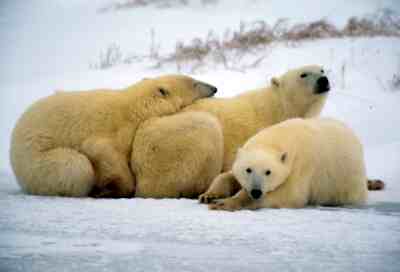Polar
Bears Walking on Thin Ice
Story by Roderick
Eime
It seems the
world’s cutest animals are those most threatened by the
ones who love them most – us.
Of the seven
short-listed finalists in the World Wildlife Fund’s (WWF)
poll for the world’s cutest animal, half are endangered
or under threat.
The huge arctic
Polar Bear (Ursus maritimus) is one such contender. And
just what is it about a giant, ferocious carnivore that can crush
a seal’s skull with one blow from its massive paw that engenders
such affection in another mammal (us) that would otherwise be
its prey?
Despite its
fearsome reputation, Polar Bears are majestic, social, caring,
intelligent beasts with an imploring, puppy-dog look that seems
to say, “go on, give us a cuddle.” But that is the
last thing you’d want to do to the world’s largest
terrestrial carnivore.
Even though
the hunting of Polar Bears is now greatly diminished, they face
an even tougher struggle against the effects of man-made global
warming. WWF studies indicate that, with the present rate of global
warming, Polar Bears will be extinct within 100 years, even if
hunting were to cease tomorrow.

Polar
Bears, female with cubs. Churchill, Manitoba Canada (c) WWF /
Kevin SCHAFER
“Polar
bears are walking on thin ice,” said Samantha Smith, director
of the WWF International Arctic Programme. “If we can secure
their future by cutting carbon dioxide emissions, we can secure
the future of thousands of other species around the world.”
The Arctic
Climate Impact Assessment (ACIA)
was produced by more than 250 scientists for arctic governments.
It provides incontrovertible proof that climate change is happening
in the Arctic and that it will get worse more quickly unless emissions
of carbon dioxide are cut.
“The
big melt has begun,” said Jennifer
Morgan, director of WWF’s global climate change campaign.
“Industrialised countries are carrying out an uncontrolled
experiment to study the effects of climate change and the Arctic
is their first guinea pig. This is unethical and wrong.”
Some, like
US Republican politicians, believe that the WWF are doomsayers
and scaremongers, that their data is flawed and that they are
naïve reactionaries, tugging on heartstrings and ignorance.
But when one considers the Republicans’ huge oil interests,
it seems unlikely they would encourage us to burn less of it.
The world’s
population of Polar Bears is estimated at around 22,000 animals,
and although this number does not appear to be falling, Canadian
Wildlife Service studies in Hudson Bay indicate that the physical
condition and breeding success of bears is definitely declining.
And while
the two opposing factions bicker over CO2 emissions,
the magnificent Polar Bears are clearly showing the strain as
their hunting ground literally melts beneath them.
Photos
coutesy WWF Canon / Jack Stein GROVE / Kevin SCHAFER
Grab
Facts (from WWF)
Habitat
and Distribution
Polar Bear
populations can be found in northern Canada, Greenland, Norway
and Russia, and there have been reports that polar bear tracks
have been found as far north as the North Pole.
Diet
Polar Bears
hunt ringed and bearded seals on the sea ice, between late April
and mid-July, by breaking into seal dens in the sea ice.
Reproduction
Polar Bears
breed in late March, April and May. The males actively seek out
females by following their tracks on sea ice. They remain with
the female for a short time, then leave in search of another female.
More
Info:
|